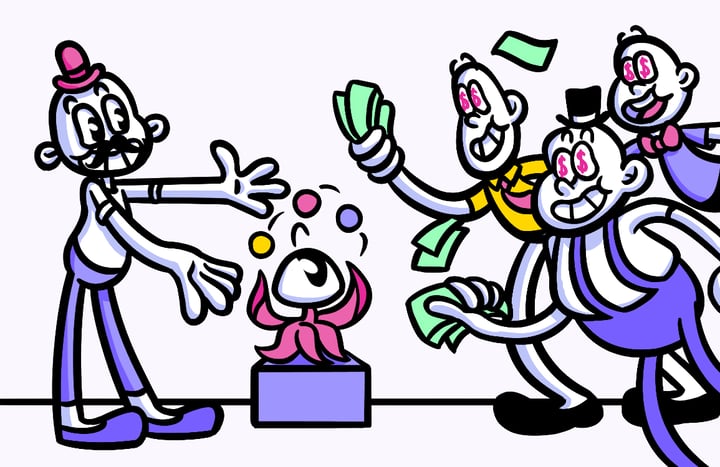What is Brand Experience? A Practical Guide
“Now you can be part of the warp speed action,” promised the defunct Star Trek: The Experience. A theme park based on the science-fiction juggernaut. And years before Disney would take visitors to a galaxy far far away.
The Experience, for short, was immersive, transporting visitors to the Starship Enterprise. An exact copy of the TV show, where you could interact with crew members and take a shuttle on a star trek (get it) of your own to a far away space station with food and drinks.
That’s what any theme park does best: give you an end-to-end experience with a brand. That you can taste, touch, and smell.
A brand experience aspires to that level of intimacy. That’s why we’ve put together this Brand Experience Guide.
Here are all the tools and information you’ll need to manage, strategize, and measure all aspects of your brand experience.

So What Classifies a Brand Experience?
Brand experience is the culmination of every interaction, touch, and moment someone might have with a brand. This creates a memorable, even meaningful, relationship between brand and customer. The more positive, the stronger the relationship.
Those experiences must be crafted and created, especially if you want to deepen a customer’s emotional connection to your brand. A bad experience ruins that. A great one gives you a loyal, lifetime customer.
And it’s not just one thing that makes an experience. There are many components that roll up into one:
- Design/Visuals
- User experience
- Content
- Voice and tone
- Customer service
- Company values, mission and purpose
All your decisions on each of those elements impacts how a customer connects with your brand.
Why Measure Brand Experience?
Designing and putting an experience into action isn’t a one and done deal. It’s an ongoing process that requires tweaks and changes. Or else your brand stagnates. That’s why measuring your brand experience is important.
Brand Experience and ROI
Everyone wants a return on their investment. It takes time and a whole lotta spending money… to do it… to do it right. Sorry, we got that George Harrison song stuck in our heads.

‘Cause, as they say, time is money. And it’s not so much important what you do, but how it’s executed. After all, execution is everything.
To get the most bang per buck spent:
- Create a cohesive experience. If you’ve got a physical product or event, then you want to ensure your digital experience is similar. Disney is great at this with their theme parks. The experience extends from the lines to the rides to even their digital Park apps.
- Publish engaging content. Articles, videos, and Tik Toks… oh my. You want to put out stuff that has people coming back for more. The more unique, the better. But it has to align with your brand’s voice, tone, and values. More importantly, it has to be valuable to your audience.
- Pay attention to metrics. Look at traffic to your site. Track sign-ups and actual sales. Look at referrals. Survey your audience to see if your efforts are having an effect. There are a variety of tools that can help you reach them, such as Helio.
Finally, a word on Brand Equity. You can get a fair amount of this from creating a memorable, lasting brand experience. If you leave a positive impression on your customers, then you’ll increase your equity. The flip side of that: a negative experience will decrease it among your audience.
How To Build A Better Brand Experience
This guide’s purpose is to help you build a solid experience for your customers. From here, we’ve written several articles linked here for a deeper dive.
This page is a supernova bursting with information. All you have to do is follow the solar winds.

Revisit Our Buyer Personas/Target audiences
The first wind you want to follow is our buyer personas and target audiences.
COMING SOON: We’ll have several templates for you to use to survey your audiences as well.
Also you’ll want to identify your brands attributes, which could include:
- Relevance. Your brand solves a need.
- Consistency. A seamless experience that’s consistent for your customers.
- Sustainable. Your brand adapts to your customer’s evolving needs.
- Inspirational. Your brand makes your customers feel a part of something bigger than themselves and forms a community.
Brand Analysis
Your next stop should be a brand analysis. You’ll want to examine the ins and outs of your brand experience. Two important elements of this are: brand awareness and brand recall. Though they sound similar they’re subtly very different.
- Brand Awareness. This is where your audience is familiar with everything that makes your brand yours, from the experience to the look and feel.
- Brand Recall. This is part of brand awareness, where people can recall your brand without being prompted to do so.
- Brand Recognition. Another important element. But this is where someone recalls your brand with a prompt.
Build Brand Perception
With any brand experience, you’ll build its perception. The more positive and consistent, the more likely it’ll create a strong emotional connection to your brand.
Things you’ll want to consider:
- Positioning Strategy. Figuring out where your product or service sits in the market is crucial to this. From that you can create the narrative you want to broadcast to your audience.
- Logo Testing. A logo test evaluates the strength of your logo design to determine the best design for your business. You can even use Helio to do so.
Brand Analysis
Knowing and understanding what your users’ brand needs is a vital part of the process. Our templates are a great way to kickstart getting in the groove of obtaining that necessary feedback. Here is one made just for brands!




